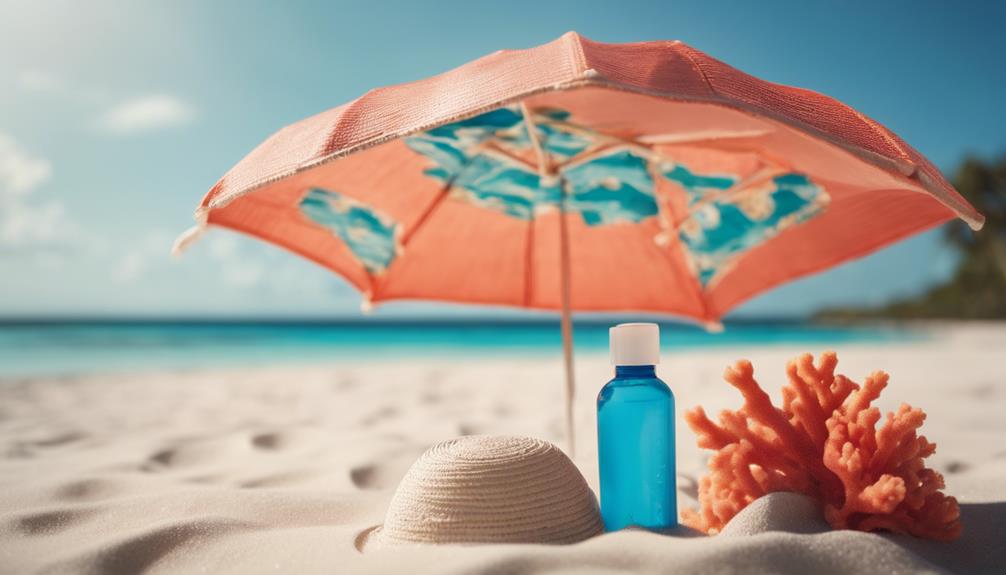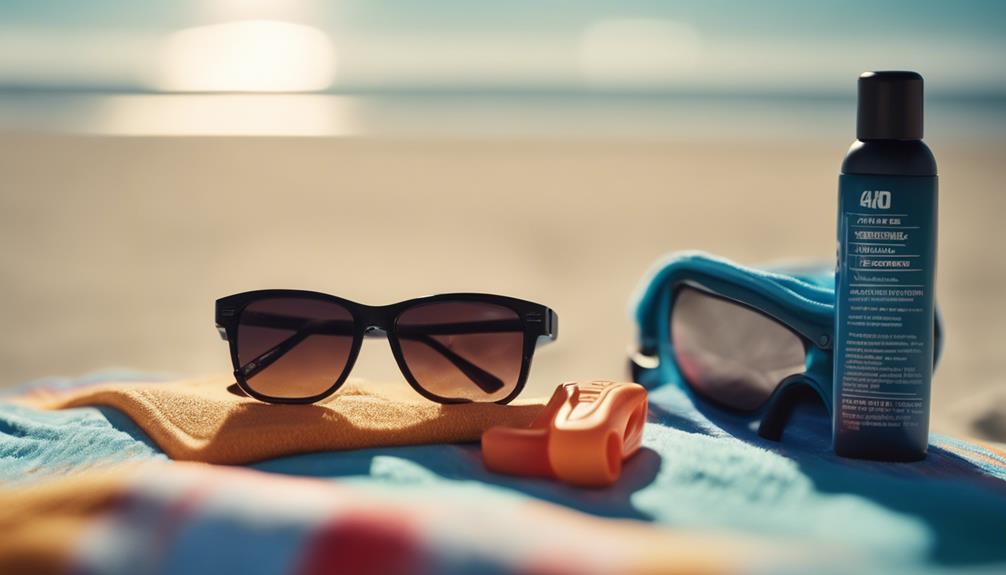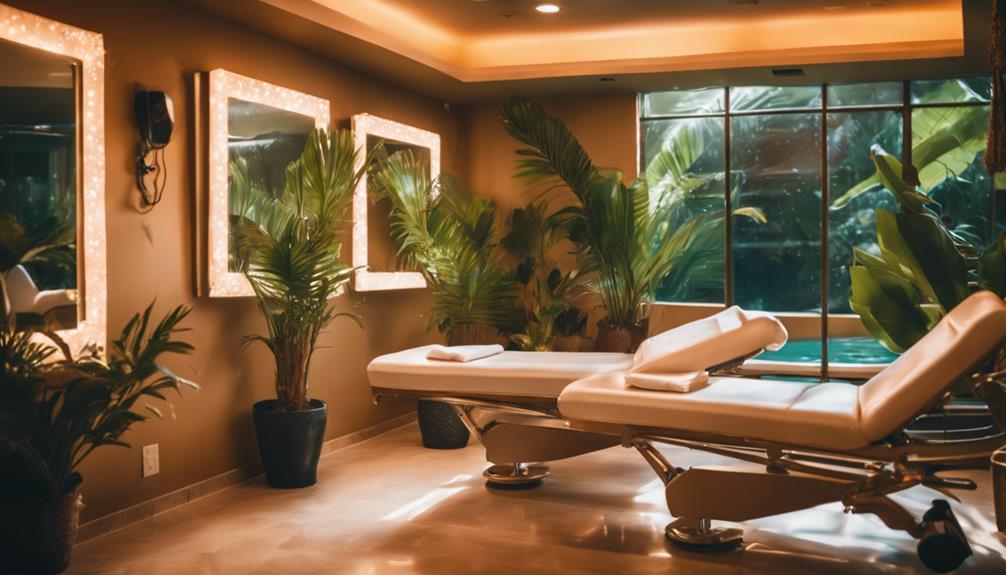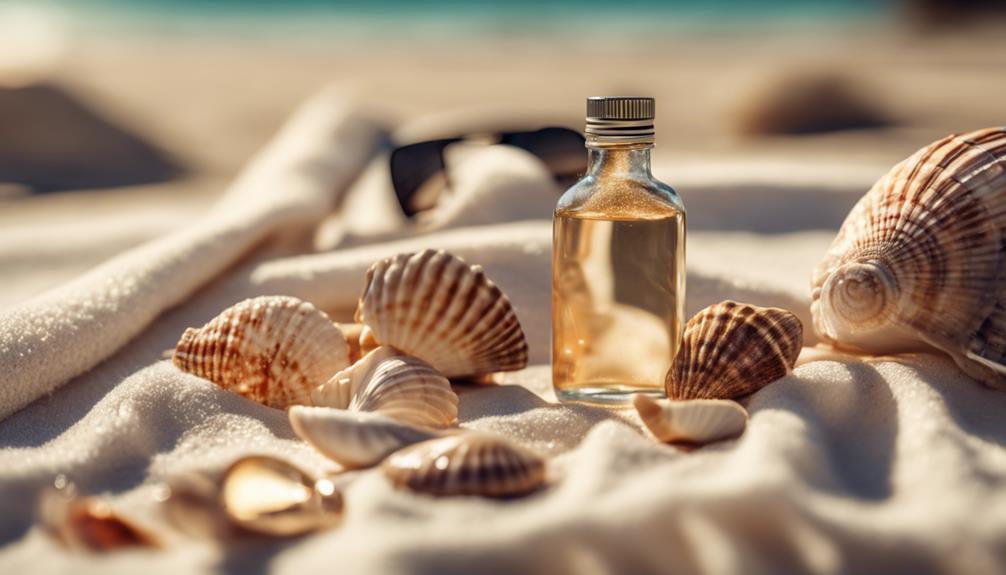To protect your skin from the dangers of tanning beds, make sure to wear UV-blocking goggles to shield your eyes. Always put on a broad-spectrum sunscreen (with at least SPF 15) before your tanning session to reduce skin damage. Additionally, wearing tightly woven clothing and wide-brimmed hats can provide extra protection. It’s important to be aware that myths about base tans being safe can actually increase the risks of skin cancer and premature aging. If you decide to tan, choose salons that comply with FDA guidelines and have clean, up-to-date equipment. Interested in safer ways to achieve a sun-kissed glow? There are plenty of effective alternatives to explore.
Key Takeaways
- Always wear UV-blocking goggles to protect your eyes from harmful tanning bed rays.
- Apply broad-spectrum sunscreen (SPF 15+) before using tanning beds to reduce skin damage.
- Use tanning bed face covers to minimize exposure to facial skin and prevent premature aging.
- Choose salons that comply with FDA guidelines and maintain modern, well-sanitized equipment.
Health Risks of Tanning Beds
Tanning beds pose significant health risks, including a heightened chance of developing skin cancer and weakening your immune system.
When you expose your skin to the UV rays from these beds, you're not just chasing a tan; you're increasing your lifetime risk of skin cancer. Research shows that regular users face a significant increase in this risk, particularly younger individuals.
Each session you spend under those harmful rays heightens your chances of developing skin cancer, as both UVA and UVB rays contribute to skin damage.
It's a common myth that a base tan can protect you, but in reality, it leads to even greater harm. The health risks far outweigh any temporary cosmetic benefits you might perceive.
Premature Aging Effects
How does exposure to tanning beds accelerate the aging process of your skin?
When you use tanning beds, the UVA rays penetrate deep into your skin, breaking down collagen and elastin, which are essential for maintaining your skin's firmness and elasticity. This breakdown leads to premature wrinkles, fine lines, and sagging skin.
You might also notice age spots appearing sooner than they should. Additionally, the cumulative damage from repeated tanning sessions makes your skin more sensitive to sunlight, increasing the risk of burns.
The temporary glow you achieve from tanning beds comes at the cost of long-term skin health, leaving you with visible signs of aging that can be hard to reverse.
Protect your skin now to prevent these unwanted effects later.
Protective Measures

To shield your skin from harmful UV rays, always wear UV-blocking goggles when using tanning beds. These goggles protect your eyes from dangerous UV exposure, which can lead to serious eye damage.
Additionally, apply a broad-spectrum sunscreen with at least SPF 15 before your session, and reapply every couple of hours. Wearing tightly woven clothing and a wide-brimmed hat can further defend your skin from UV rays.
Choose tanning salons that follow FDA guidelines, ensuring they prioritize your safety. Be aware of any medications you take that might cause allergic reactions to tanning.
Safe Alternatives to Tanning
Exploring sunless tanning products like self-tanners and spray tans offers a safe way to achieve a bronzed glow without the harmful UV exposure from tanning beds.
These products typically use dihydroxyacetone (DHA), which reacts with your skin's outer layer, creating a natural-looking tan. You can also opt for gradual tanning lotions, allowing you to build your desired shade over time without the risk of overexposure.
Additionally, consider using bronzers for a quick touch-up before an event. If you prefer a more natural approach, try natural tanning oils that nourish your skin.
Always perform a patch test to avoid allergic reactions and choose high-quality products to guarantee a beautiful, streak-free finish.
Safe tanning is just a product away!
Importance of Awareness

Awareness of the risks associated with tanning beds is essential for making informed decisions about your skin health. Understanding these dangers helps you protect yourself and avoid long-term consequences.
Here are key points to reflect on:
- Tanning beds greatly increase your risk of skin cancer, especially if you start young.
- They can accelerate premature aging, leading to wrinkles and age spots.
- Many believe a base tan offers protection, but it actually increases your skin's damage risk.
- Awareness of FDA guidelines for tanning salons can guide you in choosing safer options.
Stay educated about these risks, and you'll be better equipped to make choices that prioritize your skin's well-being over temporary cosmetic benefits.
Choosing a Safe Salon
Selecting a safe tanning salon is crucial for minimizing health risks while still achieving the desired tan. When choosing, look for salons that prioritize safety and cleanliness. Here's a quick checklist to help you decide:
| Criteria | What to Look For |
|---|---|
| FDA Compliance | Confirm salon follows FDA guidelines. |
| Sanitization | Check for regular cleaning protocols. |
| Equipment Age | Verify modern, well-maintained beds. |
| Staff Training | Look for knowledgeable, certified staff. |
| Customer Reviews | Read testimonials for client satisfaction. |
Trending Safety Products

Current trends in safety products for tanning beds focus on enhancing protection and minimizing health risks associated with UV exposure. You can take proactive steps to safeguard yourself with these trending items:
- UV-Blocking Goggles – Essential for protecting your eyes from harmful UV rays.
- Broad-Spectrum Sunscreen – Use SPF 15 or higher to shield your skin before tanning.
- Tanning Bed Face Covers – Designed to protect your face and minimize skin damage.
- Tanning Bed Towels – These help maintain hygiene and reduce exposure to bacteria in salons.
Frequently Asked Questions
How Do Tanning Beds Affect Skin Types Differently?
Tanning beds affect skin types differently due to varying melanin levels. Lighter skin may burn easily, while darker skin might tan more easily. However, both are at risk for long-term damage and skin cancer.
What Are the Signs of Tanning Bed Overexposure?
If you've overexposed your skin to tanning beds, you might notice redness, peeling, or a burning sensation. Increased sensitivity and darkened patches can also indicate damage. Always listen to your skin and prioritize its health.
Can Tanning Beds Cause Eye Damage Without Goggles?
Did you know that over 90% of tanning bed users experience eye damage without goggles? If you don't wear protective eyewear, you risk serious injuries like cataracts and retinal damage from harmful UV rays.
How Often Is It Safe to Use a Tanning Bed?
It's best to limit tanning bed use to once every two weeks, if at all. Frequent sessions increase your risk of skin damage and cancer, so consider safer alternatives for achieving a tan.
What Are the Long-Term Costs of Tanning Bed Usage?
The long-term costs of tanning bed usage include increased skin cancer risks, premature aging, and higher healthcare expenses. You'll face potential treatments and skin damage that outweigh any temporary cosmetic benefits gained from tanning.
How Can Tanning Oil Stains on Fabrics Affect Skin Health?
Tanning oil stains on fabrics can lead to skin health issues. When fabrics are stained with tanning oil, it can transfer back onto the skin, causing clogged pores and potential breakouts. To avoid these issues, it’s essential to know effective methods for banishing tanning oil stains from fabrics.
How Can I Protect My Skin from Tanning Bed Dangers and Burns?
When using tanning beds, it’s important to practice tanning bed burn prevention techniques. Always use protective eyewear and apply sunscreen before tanning. Avoid overexposure by limiting sessions and taking breaks. Stay hydrated and moisturize your skin to prevent dryness and burns. Prioritize your skin’s health and safety.
How Can I Protect My Skin from Tanning Bed Dangers and Burns?
When it comes to tanning bed burn prevention, there are a few key steps to take. First, always use a good quality sunscreen with a high SPF. Second, limit your time in the tanning bed to avoid overexposure. Finally, consider using protective eyewear to shield your eyes from potential UV damage.
What Are the Dangers of Tanning Beds and How Can I Prevent Burns?
Tanning bed burn prevention is crucial as these beds emit harmful UV rays that can cause serious skin damage. Overexposure can lead to burns, premature aging, and increase the risk of skin cancer. To prevent burns, limit tanning bed use, protect your eyes and skin, and avoid tanning during peak UV hours.
Conclusion
In summary, while tanning beds may promise a quick tan, the hidden dangers far outweigh the temporary benefits.
Studies show that using tanning beds before age 35 increases your risk of melanoma by 75%.
By opting for safer alternatives and taking protective measures, you can achieve a radiant glow without jeopardizing your skin's health.
Stay informed, choose wisely, and embrace a future where your skin remains youthful and vibrant, free from the harsh realities of UV damage.










